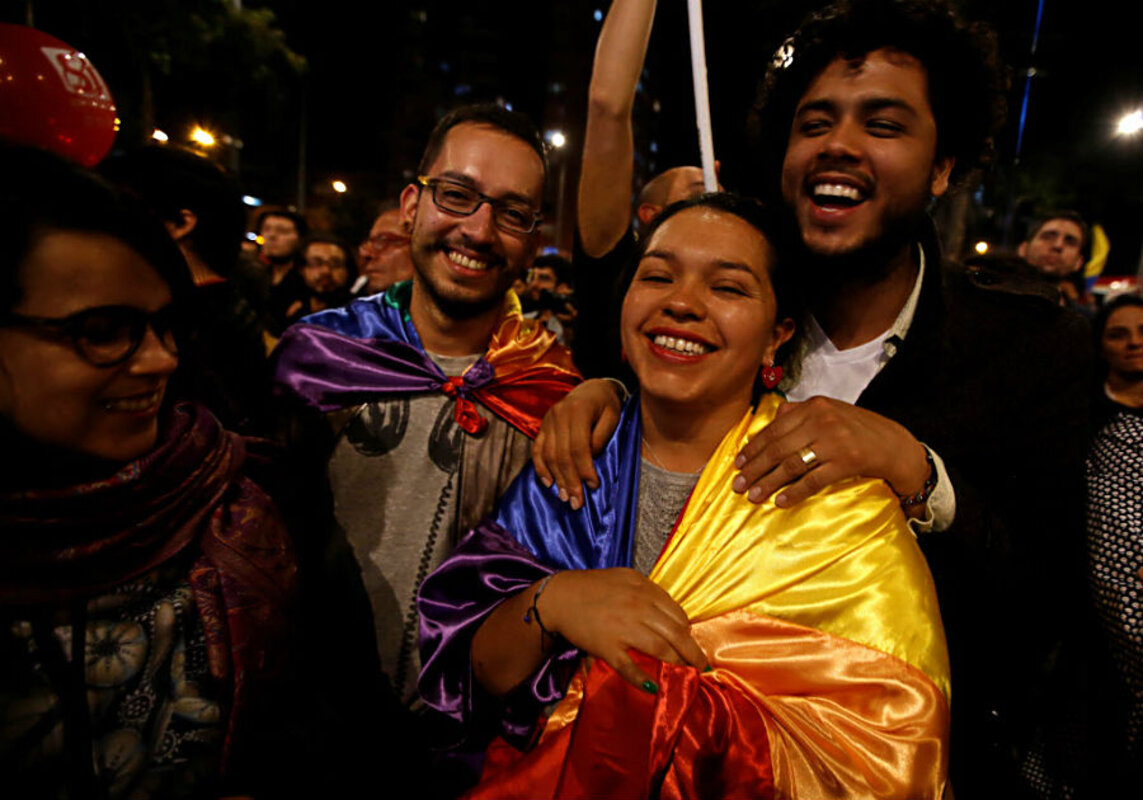Historic Colombia-FARC peace deal: questions and answers
Loading...
| Mexico City
After more than five decades of conflict and nearly four years of peace negotiations, the Colombian government and the FARC, the oldest guerrilla group operating in the Western Hemisphere, announced Wednesday night that they had reached a final peace accord.
The pact with the FARC, the Revolutionary Armed Forces of Colombia, is a key step in winding down the longest-running conflict in the Americas, which has left more than 220,000 people dead – the vast majority noncombatants – and displaced more than 6 million others.
Here is a brief overview of what this historic deal would mean.
What needs to happen to implement the peace accord?
Colombia had initiated peace talks with the FARC on numerous occasions in recent decades. But this week’s announcement marks the closest it has come to reaching a peaceful conclusion to its 52-year-old war.
“Today begins the end of the suffering, the pain, and the tragedy of war,” President Juan Manuel Santos said Wednesday night in a national address announcing the pact. “Let’s open the door together to a new stage in our history.”
The agreement was negotiated in Havana, with talks kicking off in November 2012. Pacts on specific topic areas such as rural development and drug eradication have been announced periodically. Wednesday’s historic announcement means a final document outlining the timeline for all steps, including disarmament and demobilization, political participation, and a new approach to tackling illicit coca cultivation, will be published for the public’s review and approval.
President Santos and the FARC leadership need to sign the accord and put it to a nationwide vote – slated for Oct. 2 – which would be the final step in solidifying peace for Colombia. The vote could take place before the signing, but both are required to officially end the war. To speed the process, Santos reportedly is making the full text of the accord available to both congress and the public Thursday.
Will the vote be an easy win for peace?
Not necessarily. Although one is hard-pressed to find a Colombian who wants the conflict to continue, many disagree with the way the peace process has progressed.
Concessions – including allowing demobilized FARC members to participate in politics and making available alternative sentencing for crimes – have many in Colombia questioning whether members of the FARC are getting off too easy. It’s a fight that’s been made quite visible by former President Álvaro Uribe, now a senator, who has been outspoken against Santos’ approach from the start and is leading the campaign against the peace deal.
The plebiscite is a binding yes-no vote on the accord, and 13 percent of the country’s eligible voters are required to turn out for the results to be valid. There will be a six-week period of campaigning before the vote takes place and both sides are already gearing up to win over the public.
For months, polls have shown deep divides. But a handful of surveys released last week hint that Colombians are inching toward “yes.” A poll released Aug. 17 found that nearly two-thirds of the electorate would approve the deal. Some believe that now that an agreement has been reached, citizens are more likely to allow themselves to believe peace is a real possibility. Peace negotiations have fallen apart so many times in the past that skepticism has been high over the past four years.
Others fear that the vote could go the way of Britain’s Brexit vote. Santos is experiencing particularly low approval ratings, and there’s concern that citizens may cast “no” votes to reflect unhappiness with his government.
What happens if the peace pact is approved?
If turnout meets requirements and a simple majority endorses the peace accord, the deal will be implemented and future presidents would be bound to abide by the agreement. The FARC will demobilize its remaining 7,000 members in “protected zones” monitored by the United Nations and will have roughly six months to fully disarm.
But if the “no” campaign wins, the peace agreement reached Wednesday will be void.
“The consequence of ‘No’ winning is war,” former President César Gaviria told the Colombian daily El Tiempo.
Although this is a huge step for Colombia, even if peace “wins,” it’s not a guarantee that domestic unrest and violence will end. Separate talks between the government and a smaller guerrilla group, the National Liberation Army, recently stalled. And criminal gangs that emerged from right-wing paramilitary groups over the past decade are present in the majority of the country’s departments, already active in the drug trade, and primed to take over FARC territory.
What will peace mean for Colombia’s economy?
From tourism to investment, peace is no doubt good for Colombia’s international image. However, over the course of negotiations Colombia’s economy has taken a hit. Oil prices have fallen, and the economy is only expected to grow by about 2.5 percent annually, compared with 4.4 percent in 2014. This likely will lead to the government raising taxes to help compensate for plunging oil revenues, something opponents of the peace deal label as the public paying to support the FARC.
But war is more costly than peace. And already, with a FARC cease-fire agreement in June, rural violence has fallen to its lowest point in decades. Tourism, meanwhile, nearly doubled between 2010 and 2015, according to ProColombia, the country’s tourism office.
Colombia is “already an economic powerhouse," says Jason Marczak of the Adrienne Arsht Latin America Center. "Peace will usher in new investment and bring rural areas once off-limits into the broader economy.”





